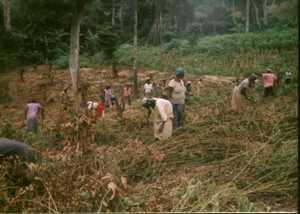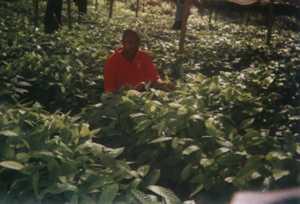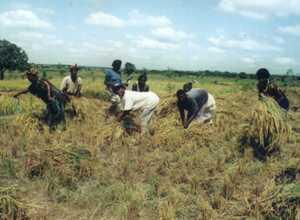Albert Addo
The project’s primary aim is to improve the environment, livelihood and health of communities’ surrounding the (Togo Plateau Tropical Ranges) zone of Ghana through the conservation and sustainable use of natural resources including medicinal plants. The global environment objective is to identify, monitor and conserve key components of the biodiversity of the (Togo Plateau Tropical Ranges) zone.

A group of local farmers engaged in unsustainable farming practices (deforestation at the Togo Plateau).
Training 40 selected local community youth leaders as conservationists, environmental advocators and peer educators who will train community members to increase awareness and build capacity of the surrounding villagers to the importance of conserving natural resources of the (Togo Plateau Tropical Range), especially Monkeys and chimpanzee’s habitats, improve resource management, medicinal plants, timber resources and reduce threats to wildlife to promote sustainable conservation and resource management of the (Togo Plateau) biological reserve.

Photograph of the large nursery plantation, a variety of tree species.
(Specifically mobilised stakeholders to adopt best training practices and strengthen awareness, tree planting, implement action-plan, protects habitats and wildlife and conserve (Togo Plateau) biodiversity geared toward environmental educational campaigns for local communities, institutions and schools to prevent timber extraction, human’s animals conflicts and wildlife extinction).

A group of women transplanting rice on pilot base on a prepared Piece of land at (Ve-kolenu rice agricultural fields.
The AHHF approach is to collaborate with farmers and local communities in identifying appropriate conservation approaches that are socially and financially sustainable. (Collaborative Agro-ecosystems Management), (Sustainable Land use Conservation and Management), (Agroforestry and intensification using indigenous species), (mobilizing people for conservation while improving their income through alternative livelihood activities). Lessons learned from these activities (e.g., the untapped potential of agrobiodiversity as a contribution to biodiversity conservation, etc.) will be brought to bear on the design and implementation of this project.
To achieve successful natural resource management, people need to understand the practical importance of biodiversity conservation and see it working in their local context. This component aims to develop such awareness and understanding through two inter-linked activities; a) the development and implementation of a general biodiversity conservation and awareness program including the multiple practical uses of the diverse natural resources of the region, and b) codification and dissemination of best management practices for land degradation control and rehabilitation, rehabilitation and woodlot development, fire prevention and control.